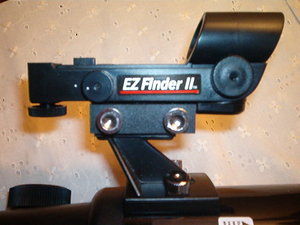Do you have an old 60mm telescope in your closet, basement or garage? They have been sold for decades under brand names like Tasco, Jason, Bushnell, and Mead. They can be a gateway to a new hobby and a whole universe. But, unfortunately, 60mm telescopes also have a number of drawbacks that can frustrate new users and drive them away from astronomy before they’ve even started. Amateur astronomers generally fall into two camps. The first camp derisively calls them Department Store Telescopes (DSTs), asserts that they are nearly useless, and discourages anyone from buying them. The second camp remembers them fondly as the telescopes of their youth, realizes their limitations, and tries to maximize their potential. If you’d like to try observing with your 60mm telescope, this guide will offer some easy tips and techniques for making your 60mm telescope more useful.
The first improvement doesn’t involve buying anything new. Instead, it involves throwing out some of the most frustrating parts of a department store telescope. You can usually discard the 4mm eyepiece and 2x Barlow without any problem. The 4mm eyepiece usually provides 175 to 225x magnification, but the theoretical maximum magnification that a 60mm telescope can handle is 120x. The 4mm eyepiece also offers a frustrating narrow field of view that makes the telescope difficult to keep on target. The Barlow is almost as bad. Typically, it is made of cheap optical components and can be frustrating to use.
The second improvement to your 60mm refractor involves the little finder scope that mounts along the side of the main telescope tube. These finders are notoriously difficult to align, counter-intuitive to use, and horribly frustrating. Fortunately, it can easily be replaced for as low as $10. Hobbyists recommend that you replace or supplement your finder scope with a red-dot sight. This inexpensive optical device is powered by a watch battery. When you switch it on, it projects a tiny red dot in the middle of a small glass sight. A red dot finder does not offer any magnification, but it is easy to align and intuitive to use. You can mount it on your optical tube very simply using double sided adhesive tape like you’d use to mount a wall poster. Simply mount it and adjust it so that when the red dot is on an object you can see the object through the telescope.
The third improvement involves the eyepieces. The eyepieces for most 60mm department store telescopes are of the simplest design called the Huygens. If you’d like to see sharper images, you’ll want to get eyepieces of a Kellner or Plossl design. Unfortunately, these more advanced eyepieces are not always easily available for older telescopes with .965-inch focusers and diagonals. If you search the Internet, you may find a few advanced eyepieces manufactured from recycled or surplus optics at the SurplusShed. Alternatively, used examples of advanced .965-inch eyepieces are available from vendors like HandsonOptics. Most people are better off searching for a .965 to 1.25-inch hybrid diagonal that allows the use of newer eyepieces in older telescopes. Once you have a hybrid diagonal, you can easily get Kellner or Plossl eyepieces. You’ll want to get a low power eyepiece with a 20 to 25mm focal length, a medium power eyepiece with a focal length of 12 to 17mm, and a high power eyepiece with a 6 to 10mm focal length. The Orion Explorer II series of eyepieces are an excellent economy eyepiece for use with 60mm telescopes. These 1.25-inch eyepieces offer a quantum leap in performance from typical original equipment Huygens eyepieces.
The fourth improvement involves the mount. Typical 60mm telescopes have notoriously shaky mounts. You can make yours a little more stable by adding weight to legs or by replacing the triangle that allows the tripod to fold with a solid piece of wood that keeps the legs completely rigid. Many astronomers give up on the original 60mm telescope tripod completely and build their own. Alternative mount designs are readily available on the Internet for hobbyists with rudimentary wood working skills.
Finally, the fifth improvement involves your brain. A little knowledge of the moon and the night sky can make a vast difference in your observing success. A subscription to a magazine like Sky and Telescope or Astronomy can equip you with the knowledge you need to observe successfully. Software like The Sky from Software Bisque or Starry Nights from Imaginova can help you locate objects and print out maps of the night sky. With a sky map, you can easily plan your observing session.
These simple steps can vastly improve your observing experience with a 60mm telescope. You just need to take the steps to find your old telescope and dig it out. I think your 60mm telescope might be in the basement by the golf clubs or tennis rackets. Good luck!
